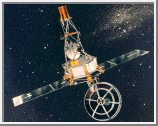
Mariner 2, the world's first successful interplanetary spacecraft, was launched August 27, 1962. It reached Venus on December 14, 1962, after a 108-day journey from Earth. Mariner 2 was a 200-kilogram (450-pound) machine carrying six scientific instruments, a two-way radio, a solar-power system, and assorted electronic and mechanical devices. Its crew, numbering roughly 75, stayed behind at NASA's Jet Propulsion Laboratory.
The Mariner planetary spacecraft series began in 1960 as a group of mission studies at JPL; by 1975, there had been 10 Mariner flights, seven of them successful explorations of the inner Solar System. The Mariner 2 mission was authorized by NASA in August 1961, less than a year before the first launch window. The limited capacity of Atlas/Agena, the largest available launch vehicle, severely restricted launch opportunities and spacecraft size. The first launch, Mariner 1, was aborted when its launch vehicle strayed from the safe flight corridor and was destroyed by the Range Safety Officer.
Liftoff
A few minutes before 2 a.m. on August 27, 1962, Mariner 2 lifted off the pad at Cape Canaveral aboard its Atlas-Agena rocket. It was nearly as much an experiment for the rocket and spacecraft engineers as for the space scientists intent on observing interplanetary space and the planet Venus.During its three-and-a-half-month odyssey of some 290 million kilometers (180 million miles), reaching a third of the way around the Sun to Venus, Mariner 2 transmitted coded signals continuously to the Earth, mixing scientific measurements of interplanetary dust, magnetism, cosmic rays and solar plasma with engineering data on the health and performance of the spacecraft.
As Earth turned beneath the feeble radio transmissions, three great steerable antennas (now the Deep Space Network) captured Mariner's signals in turn, first in California, then Australia, Africa and California again.
Mariner 2 suffered and survived a number of unanticipated events during the flight. It lost its attitude orientation; one of the solar panels failed; many temperature readings rose ominously as Mariner approached Venus; and, just before the Venus encounter, the computer/sequencer became erratic. But, Mariner automatically recovered its orientation, survived solar heating, and, as sunlight grew more intense, one solar panel did the work of two. When the flight engineers saw the sequencer faltering, they started the encounter sequence by radio commands from Earth.
On December 14, 1962, Mariner's infrared and microwave radiometers scanned back and forth across the planet, capturing data that would prove Venus's surface to be fire-hot -- about 425° C (800° F) -- warmed in part by a runaway greenhouse effect in the thick carbon dioxide atmosphere. About three weeks after its historic Venus flyby, Mariner 2 went off the air. Its signal was last received on January 3, 1963.
 Mariner 2
Mariner 2
Mariner 2, the world's first successful interplanetary spacecraft, was
launched August 27, 1962, and passed 34,916 kilometers (21,648 miles)
from Venus on December 14, 1962. Contact was lost January 3, 1963, when
the spacecraft was 86.9 million kilometers (53.9 million miles) from
Earth. (Courtesy NASA)
Sonett, C. P. "A summary review of the scientific findings of the Mariner Venus Mission." Space Science Review, 2, No. 6, 751-777, December 1963.

 Space History
Space History